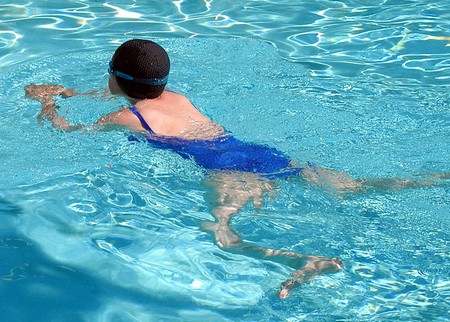“Has anyone seen a frog jumping or swimming? If you have, that’s what the breaststroke looks like.”
I have often heard that the breaststroke is so easy, so graceful, so natural, and I say, to teach the correct breaststroke is absolute murder. It’s ugly and very unnatural.
The breaststroke used to be pretty and graceful until Americans altered it. It was analyzed, it was photographed, it was dissected, and all movements that were graceful were cut out. The breaststroke was turned into a power stroke.
There is nothing much wrong with the breaststroke itself, but the swimming rules make it very difficult: the arms and legs are not allowed to break the surface of the water; everything has to be symmetrical; after diving in and turning, the swimmer is not allowed to do more than one stroke underwater; at the touch of the wall both hands should touch at the water level. It’s easy to teach somebody the breaststroke, that is, a style that resembles the breaststroke. But it’s very, very difficult to prepare a child for competition.
Kicking
Before taking children into the water, they have to be shown how the breaststroke kick works. So, have them sit on the floor, balancing on their backside, and draw both their knees up with their heels facing each other and their toes turned out; now they should straighten their legs out, then bring them together.
Or have them standing, feet turned out, heels facing each other (a bit like first position in ballet). Then they should squat down, turning their knees out and keeping their heels firmly on the floor. While the children are squatting, explain that this is how you want them to hold their legs when they commence the kick.
Another exercise is for them to face and lean on the wall, draw one knee up with feet turned out sideways, then stretch their leg out backwards in a straight line without dropping out of the level, then draw their leg back again to the original position. If the children repeat this about ten times, they will feel the muscles in their thighs that are needed for breaststroke kicking.
In the water, have them practice breaststroke kicking, holding on to the side of the pool. Make sure that they don’t drop a knee and that they keep both of their feet turned out.
Once they’ve mastered these drills, say to them, “I want you to hold your arms out in front, don’t move them, take a deep breath, hold it, and try to breast-stroke-kick across the pool.”
After a few tries, with their feet only, they can try to move their arms as well.
Arm Movements
Standing in shoulder-deep water facing the pool, their arms should be stretched out in front. They should turn the back of their hands together (like an inside-out praying position), then gently pull sideways, about two inches under the water level. When their arms are out fairly wide, they should bend them from the elbow, gently bringing their arms toward each other, then they should push out in front.
Breathing
Breathing for the breaststroke is similar to that of the butterfly stroke. You can breathe on every stroke or every second stroke. In the early learning stages, I usually tell the children to breathe whenever they feel like it. Some of them will swim holding their heads in for about three or four strokes before they come up for air, and some will come up every stroke.
In the advanced stage, swimmers come up for air every stroke. The head should come up for air when the arms are bending halfway through the stroke. The head stays down while the arms go out to the front, glide, and pull back again to the bent-elbow position. The breathing in has to be very quick and the blowing out very slow.
When children learn the breaststroke, they have to spend many hours on the kicking board practicing the kick.
